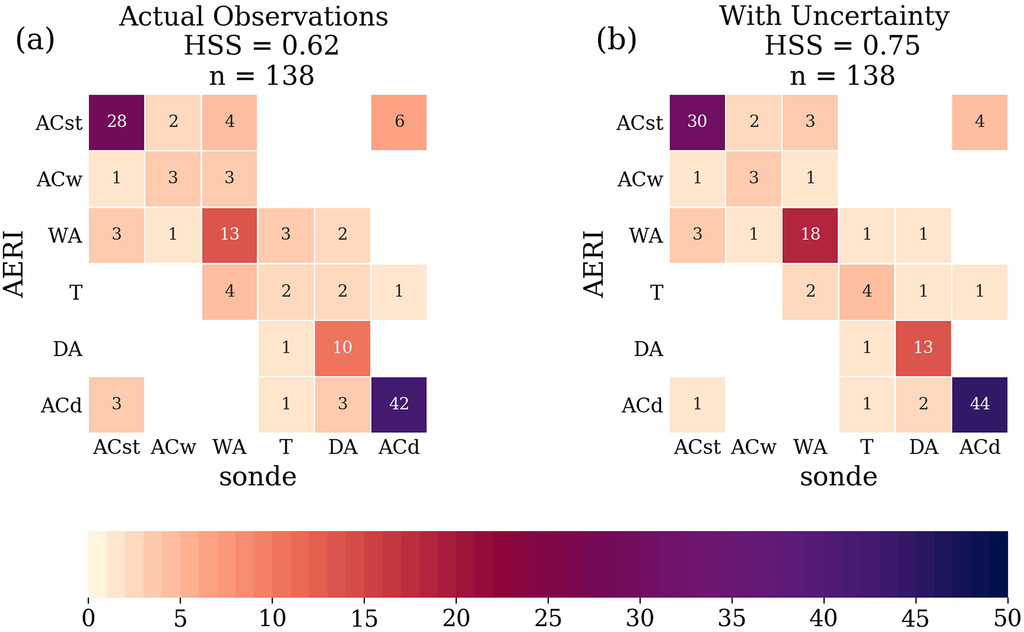Evaluation of a land-atmosphere coupling metric computed from a ground-based infrared interferometer
Submitter
Turner, David D.
— NOAA Global Systems Laboratory
Area of Research
Atmospheric Thermodynamics and Vertical Structures
Journal Reference
Wakefield R, D Turner, and J Basara. 2021. "Evaluation of a land-atmosphere coupling metric computed from a ground-based infrared interferometer." Journal of Hydrometeorology, 22(8), 10.1175/JHM-D-20-0303.1.
Science

Figure 1. Contingency matrix comparing CTP-HI classifications obtained based on radiosonde versus AERI CTP-HI observations and Heidke skill scores (a) without window of uncertainty and (b) including AERI window of uncertainty. The color bar corresponds to number of counts, and this number is also annotated directly within the matrix. From journal.
Land-atmosphere coupling metrics are a useful tool for quantifying the relative role of the land surface in driving planetary boundary layer (PBL) processes as well as development (or suppression) of convective precipitation. Our work leverages the higher temporal resolution offered by the atmospheric emitted radiance interferometer (AERI) to evaluate uncertainties associated with applications of a frequently used land-atmosphere coupling metric using remotely sensed thermodynamic profiles.
Impact
Process-level land-atmosphere coupling metrics often benefit from atmospheric thermodynamic profiles, such that availability of radiosonde observations often limits observational application of these metrics. Our results suggest that future studies can confidently employ thermodynamic profiles from the AERI to evaluate various land-atmosphere coupling metrics with high temporal resolution and limited uncertainty.
Summary
Land–atmosphere feedbacks are a critical component of the hydrologic cycle. Vertical profiles of boundary-layer temperature and moisture, together with information about the land surface, are used to compute land–atmosphere coupling metrics. The convective triggering potential and low-level humidity index (collectively referred to as CTP-HIlow framework) is a popular coupling metric that uses morning vertical profiles of moisture and temperature to diagnose the likelihood of convective precipitation over wet or dry soils. Combinations of CTP (a measure of instability) and HIlow(a measure of moisture) are used to categorize the atmospheric preconditioning for convection given initial soil moisture conditions. Radiosonde- versus AERI-based computations of CTP and HIlowproduced the same diagnosis of atmospheric preconditioning a majority of the time. The AERI’s ability to represent this coupling metric well enabled novel exploration of temporal variability within the overnight period in CTP and HIlow.
Accumulated net radiation during morning radiosonde observations can vary zonally such that a morning radiosonde in Denver may occur before sunrise, while the same morning radiosonde would occur after sunrise in Long Island. This motivated an evaluation of uncertainty in the metric depending upon accumulated net radiation at a given site to represent this zonal variability. Observations of CTP-HIlow computed within a few hours of 1200 UTC were essentially equivalent; however, with greater differences in time there arose greater differences in CTP and HIlow.
Keep up with the Atmospheric Observer
Updates on ARM news, events, and opportunities delivered to your inbox
ARM User Profile
ARM welcomes users from all institutions and nations. A free ARM user account is needed to access ARM data.


















